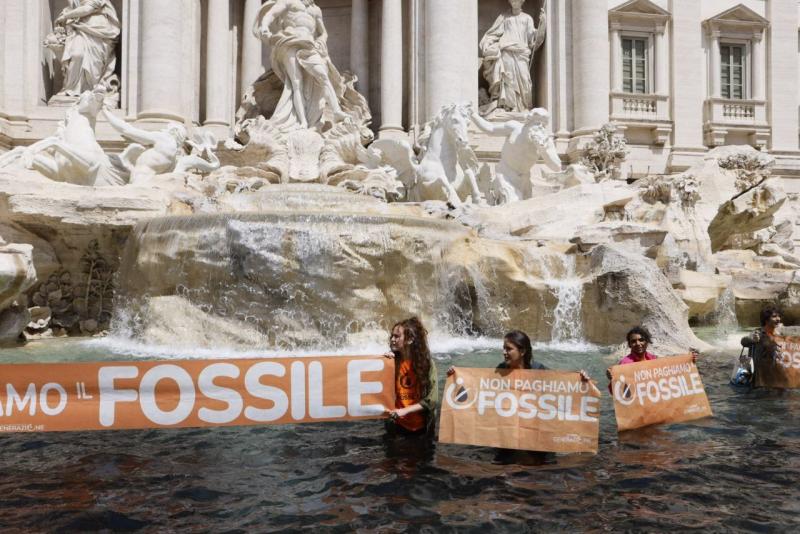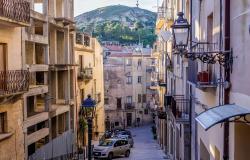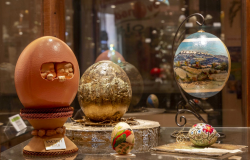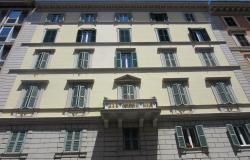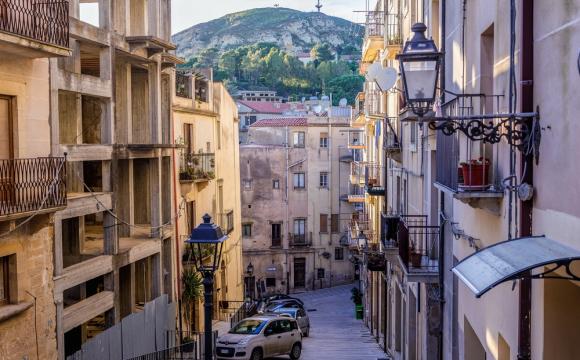The emerging European trend of climate activists targeting artworks and historical monuments with paint and other liquids is generating varying degrees of both support and outrage across Italy.
One high-profile incident that occurred last week saw a group of activists from the Italian movement Ultima Generazione (Last Generation) climb into the Trevi Fountain in Rome and pour a vegetable-based carbon liquid into the water.
“I’m Mattia, I'm 19 years old, and I have chosen to engage in civil disobedience because the horrible tragedy experienced in recent days in Emilia Romagna is a warning of the dark future that awaits humanity,” said one of the activists as he stood in the famous Baroque fountain. Tourists visiting the landmark alternately took photos, applauded and booed.
“The floods that have killed 14 people in the country’s northeast were a warning. The disaster has activated fear, anxiety, and anger within me. Our country is dying!” shouted Mattia’s 18-year-old friend Charlie.
Within 20 minutes, the protesters were pulled out and escorted away by police. Police also confiscated their banners, adorned with slogans protesting government-funded fossil fuel projects.
Two days after the Trevi Fountain event, a pair of bare-chested protesters smeared themselves with mud outside the Senate building in Rome. Police quickly removed the two, while some passersby showed support and others insulted them.
Support and pushback
Marco Rovelli, a 54-year-old musician, writer and secondary school teacher from Milan, is among the activists’ sympathizers. He believes that older generations are leaving younger ones with an uncertain future.
“Those who attack these activists believe that climate change is not a problem at all, which goes against all claims by climatologists,” Rovelli told Italy Magazine.
On the other hand, Alessio Postiglione, a professor at Rome Business School and Luiss University, questions the efficacy of the activists’ methods of protest.
“That is not the way to protest and to position climate change as the greatest problem facing humanity,” Postiglione told Italy Magazine. “[These activists] are extremists, obsessed with the wrong ideology.”
“We will not face extinction in 20 years. We can address how to reduce greenhouse gas emissions, but without [this] madness and with more pragmatism,” Postiglione added.
Are the consequences counterproductive?

Carlotta Muston, the spokeswoman of the Last Generation movement, claims that the group consults with experts and curators before taking any sort of action, clarifying that their goal is not to destroy artworks or monuments. The group said, in fact, that the carbon liquid used for the Trevi Fountain protest did not damage the landmark.
But Rome mayor Roberto Gualtieri noted right away that the Trevi Fountain cleanup efforts would cost significant time, money and water, because the fountain uses a recirculating system.
“Enough with these absurd aggressions against our artistic heritage,” Gualtieri tweeted. “The restoration process is costly and complex, and we sincerely hope there won’t be any permanent damage. I invite activists to engage in constructive dialogue without endangering the safety of our monuments.”
In a longer statement published on Facebook, Gualtieri said that the process of emptying and refilling the fountain would ultimately see 300,000 liters of water go to waste.
“These sorts of gestures are completely wrong and harmful, because they risk damaging precious common goods, and force public administrations to carry out very expensive and environmentally impactful restoration work,” Gualtieri wrote shortly after the incident. “So they are completely counterproductive, and also risk negatively impacting public opinion toward the just battle for the environment and climate.”
Later that same day, Gualtieri tweeted that operations had finished and that the Trevi Fountain could “go back to enchanting the world.”
Back in mid-March, Gualtieri’s mayoral counterpart in Florence, Dario Nardella, made headlines (and memes) when he tried to physically block Last Generation activists as they spray-painted part of the façade of Palazzo Vecchio, Florence’s city hall. Speaking to the first cluster of reporters, Nardella called the activists “barbarians,” adding that the methods were “not how one protests [...] Civilization must be defended.”
In Milan, meanwhile, the yellow paint that the same group of activists poured on one of the city’s most significant monuments, the statue of Vittorio Emanuele II, stubbornly remains, though the act of protest took place over two months ago. The municipality of Milan has said that the paint cannot be removed with ordinary water and has noted that the monument will need to be restored.
But Carlotta Muston contends that Milan’s lack of action and insistence on restoration is political, since the same paint was previously used to deface the La Scala opera house and was successfully removed.
Italy ranks sixth in the world in fossil fuel investments
During 2021, Italy invested €41.8 billion in the fossil fuel industry. That is more than Russia and Saudi Arabia.
One of the demands of the “Stop Fossil Fuel Subsidies” campaign, which these climate activists have been carrying out in Italian cities in recent months, is for the money invested in fossil fuels to be redirected towards the so-called ecological transition.
The partly state-owned Italian oil company ENI made a profit of €20.4 billion in 2022 alone. This is the highest profit ever earned — more than double that of 2021, due to the high price of gas.
Another example of government investment in fossil fuels comes from the German village of Lützerath, where residents have been evicted to make way for a coal mine.
The Italian banks Intesa Sanpaolo and Unicredit have provided subsidies to the Essen-based German multinational energy company RWE, which plans to expand the mine in this village.
“We value art, we don't destroy it”

Last Generation pointed to a report by the Bank of Italy earlier this month that found that 23% of Italian homes were at risk of flooding, at a potential annual cost of €3 billion.
“While the climate crisis knocks at the door, breaking riverbanks and flinging fish into the streets, the Italian government cuts resources for soil protection and fails on climate change mitigation,” representatives of this movement said.
Maria Letizia Ruello is a university researcher from Senigallia, where 13 people died last year due to heavy rains. She has participated in some roadblocks and was part of the group that threw flour on a car painted by Andy Warhol that was on display in an exhibition in Milan last year.
“If you don't ask your government to stop investing in fossil fuels, you end up being complicit in endangering lives,” Ruello said.
“Throwing flour at Andy Warhol's car may seem trivial and amusing, but through it we aimed to highlight the gravity of the issue of climate change, which authorities conveniently overlook,” Carlotta Muston explained.
On the other hand, Eike Schmidt, the director of the Uffizi Galleries in Florence, believes that violence, even if symbolic, generates even greater violence. In one interview with the Italian daily La Repubblica, Schmidt said that these activities only seek to draw attention, and that the activists’ methods are not supported by 99.9 percent of citizens.
In July 2022, 23-year-old Laura and her friend Alessandro protested in front of Sandro Botticelli’s Primavera, gluing their hands to the painting as many museum visitors looked on. Then, she and her friend lay on the floor while museum security tried to remove them.
Tommaso Galligani, spokesperson for the Uffizi Galleries, said that climate activists use art to gain as much publicity as possible.
“Artworks are universal symbols, and when they are attacked, no one can remain indifferent to such an act,” said Galligani.
